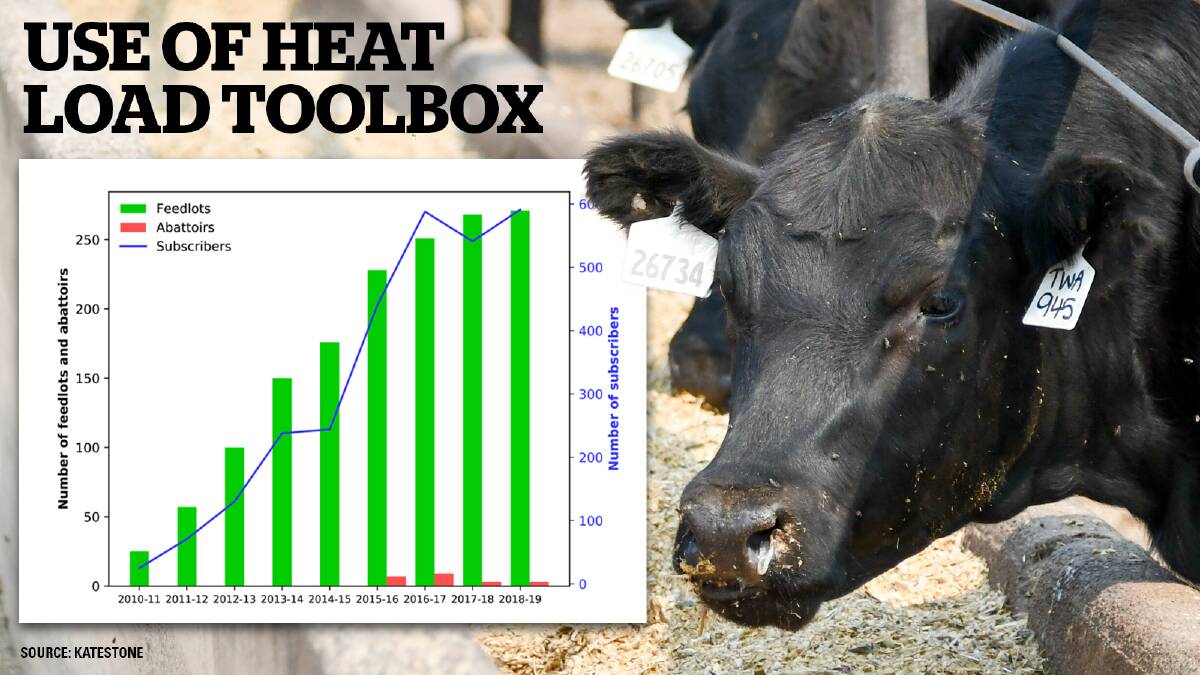
Widespread use of sophisticated heat stress management in cattle should provide a solid armoury for feedlot operators on high alert as rain-induced humidity and extreme heat sets in.
Subscribe now for unlimited access to all our agricultural news
across the nation
or signup to continue reading
Despite temperatures in excess of 40 degrees Celsius and bushfire-conducive conditions across the big lotfeeding regions, accumulated heat loads have so far been kept in check by low humidity and windy conditions, industry leaders report.
Alert thresholds via the Australian industry's world-leading web-based risk assessment and site-specific forecast system have been low.
More alerts were sent during the two previous summers, even though there has been an increase in the number of users of the Cattle Heat Load Toolbox (CHLT) weather forecasting services.
Funded by Meat & Livestock Australia and delivered by environmental consulting company Katestone's Weather Intelligence arm, the CHLT is used by feedlot managers on a daily basis to assess the potential heat risks for their sites for up to seven days ahead.
Conditions are forecast for their site location, not just the closest town.
Based on these alerts, feedlot operators take preventative measures such as modifying the energy level in rations, adding extra temporary water troughs and strategic cleaning of high manure areas.
Weather Intelligence chief executive officer Christine Killip said this December, 10 per cent fewer alerts were sent than in December 2018 and 40pc fewer alerts than in December 2017.
The number of feedlots registered has increased tenfold since 2011. All the large feedlots are using the service with over 90 per cent of the Australian herd protected, Ms Killip said.
"The lesson that we might learn from this episode is that heat stress on cattle does not rely on temperature only and high-risk conditions for fire usually means it's very hot but the heat load is low and not typically a problem for feedlot cattle heat-stress," she said.
The recent rain across many parts of Australia and forecast rains for Queensland, however, is a potential cause for concern.
Australian Lot Feeders Association president Bryce Camm said lot feeders had become well-tuned to the importance of keeping an eye out for heat events and making sure their operations can respond accordingly.
The industry had invested heavily over the years to better understand heat and what strategies could be used to aid cattle comfort and help prevent heat load events, he said.
National Feedlot Accreditation Scheme requirements include heat management plans, which are reviewed internally every six months and also during the annual audit process.
"In the lead-up to summer feedlots typically review their plans well in advance of the onset of hot weather," Mr Camm said.
"Feedlot operators then use forecasting tools, daily weather information, onsite risk assessment and, of course, daily monitoring of the cattle to determine when their plans need to be put into practice," he said.
Timing of diet changes
The latest investment in heat stress management know-how is a heat load nutrition program, just being wrapped up by Meat & Livestock Australia and the CSIRO.
The research examined the timing of implementation of heat load management diets for feedlot cattle.
Typically, with an approaching heat load event lot feeders transition cattle to a diet with more roughage and a moderate grain content, MLA feedlot project manager Dr Joe McMeniman explained.
"Anecdotal evidence from lot feeders suggests cattle cope better with these diets.
"Little, however, is known about the timing of the implementation relative to heat event onset."
Key findings of the research were cattle cope better with pro-active implementation of the heat load management diets two days prior to an event, as opposed to implementing the diet re-actively the day of an event.
MLA, in consultation with ALFA, is also currently investing in further evaluation of shade and shelter types for Australian feedlots in 2020.
"The majority of our previous research in this space has been conducted at Theodore and Gatton in Queensland. There is interest from industry in increasing shade allocation and looking at novel structures that can protect against both rain and heat in diverse geographical regions," Dr McMeniman said.
Start the day with all the big news in agriculture! Click here to sign up to receive our daily Farmonline


